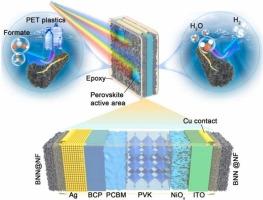Perovskite-Driven Solar Reforming of PET Waste and Concurrent Hydrogen Production
IF 17.1
1区 材料科学
Q1 CHEMISTRY, PHYSICAL
引用次数: 0
Abstract
Effectively managing the environmental burden of plastic pollution while simultaneously meeting global energy demands necessitates the development of innovative technological and systemic solutions. Herein, we present a photoelectrocatalytic system that upcycles polyethylene terephthalate (PET) waste into formate while co-producing hydrogen fuel using a bifunctional boron-doped NiMoO4/Ni(OH)2 on nickel foam, denoted BNN@NF. The BNN@NF catalyst achieves exceptional catalytic performance with a low overpotential of 48 mV at 10 mA cm-2 for HER and a Faradaic efficiency of 94.6% for the oxidation of PET-derived hydrolysate into formate. In-situ mechanical analysis reveals that the enhanced catalytic performance of BNN@NF is attributed to the superhydrophilic surface accelerating HER kinetics and the highly exposed Ni3+ species for C-C cleavage of ethylene glycol into formate. By integrating BNN@NF with a perovskite solar cell in a wireless "artificial leaf" configuration, we demonstrate simultaneous production of H2 (985 µmol cm-2 h-1) and formate (42 µmol cm-2 h-1) without external bias. This work introduces a solar-driven pathway to upcycle waste plastics into value-added products, bridging environmental remediation and renewable energy storage.

钙钛矿驱动的PET废料太阳能重整及同步制氢
有效管理塑料污染的环境负担,同时满足全球能源需求,需要开发创新技术和系统解决方案。在此,我们提出了一种光电催化系统,该系统将聚对苯二甲酸乙二醇酯(PET)废物升级为甲酸盐,同时在泡沫镍上使用双功能掺硼NiMoO4/Ni(OH)2共同生产氢燃料,标记为BNN@NF。BNN@NF催化剂具有优异的催化性能,在10 mA cm-2下,HER的过电位低至48 mV,将pet衍生的水解产物氧化成甲酸盐的法拉第效率为94.6%。原位力学分析表明,BNN@NF催化性能的增强是由于超亲水性表面加速了HER动力学和高暴露的Ni3+物质对乙二醇C-C裂解成甲酸酯的催化作用。通过将BNN@NF与钙钛矿太阳能电池集成在无线“人造叶子”结构中,我们展示了同时生产H2(985µmol cm-2 h-1)和甲酸(42µmol cm-2 h-1)而没有外部偏置。这项工作介绍了一种太阳能驱动的途径,将废塑料升级为增值产品,连接环境修复和可再生能源储存。
本文章由计算机程序翻译,如有差异,请以英文原文为准。
求助全文
约1分钟内获得全文
求助全文
来源期刊

Nano Energy
CHEMISTRY, PHYSICAL-NANOSCIENCE & NANOTECHNOLOGY
CiteScore
30.30
自引率
7.40%
发文量
1207
审稿时长
23 days
期刊介绍:
Nano Energy is a multidisciplinary, rapid-publication forum of original peer-reviewed contributions on the science and engineering of nanomaterials and nanodevices used in all forms of energy harvesting, conversion, storage, utilization and policy. Through its mixture of articles, reviews, communications, research news, and information on key developments, Nano Energy provides a comprehensive coverage of this exciting and dynamic field which joins nanoscience and nanotechnology with energy science. The journal is relevant to all those who are interested in nanomaterials solutions to the energy problem.
Nano Energy publishes original experimental and theoretical research on all aspects of energy-related research which utilizes nanomaterials and nanotechnology. Manuscripts of four types are considered: review articles which inform readers of the latest research and advances in energy science; rapid communications which feature exciting research breakthroughs in the field; full-length articles which report comprehensive research developments; and news and opinions which comment on topical issues or express views on the developments in related fields.
 求助内容:
求助内容: 应助结果提醒方式:
应助结果提醒方式:


